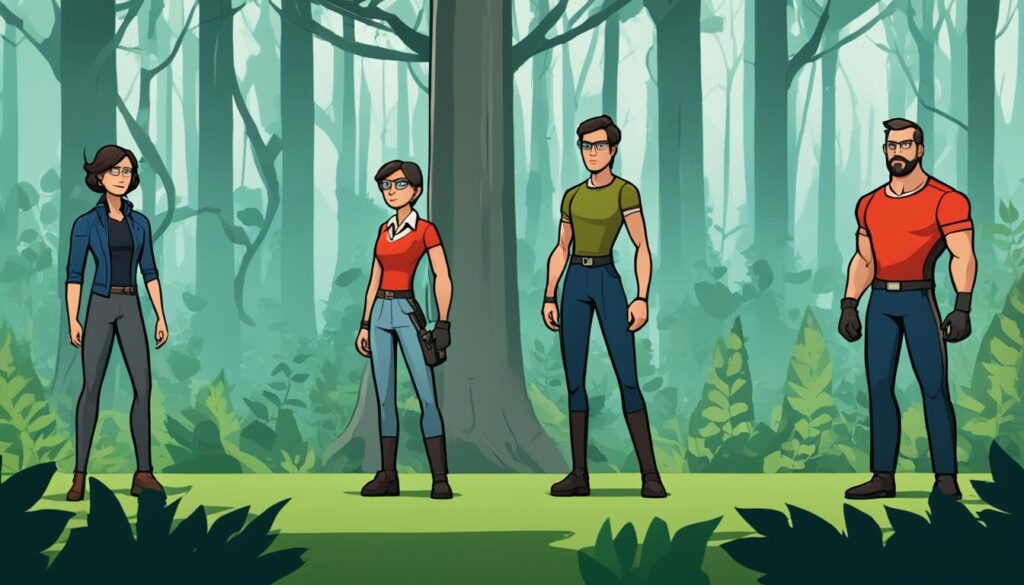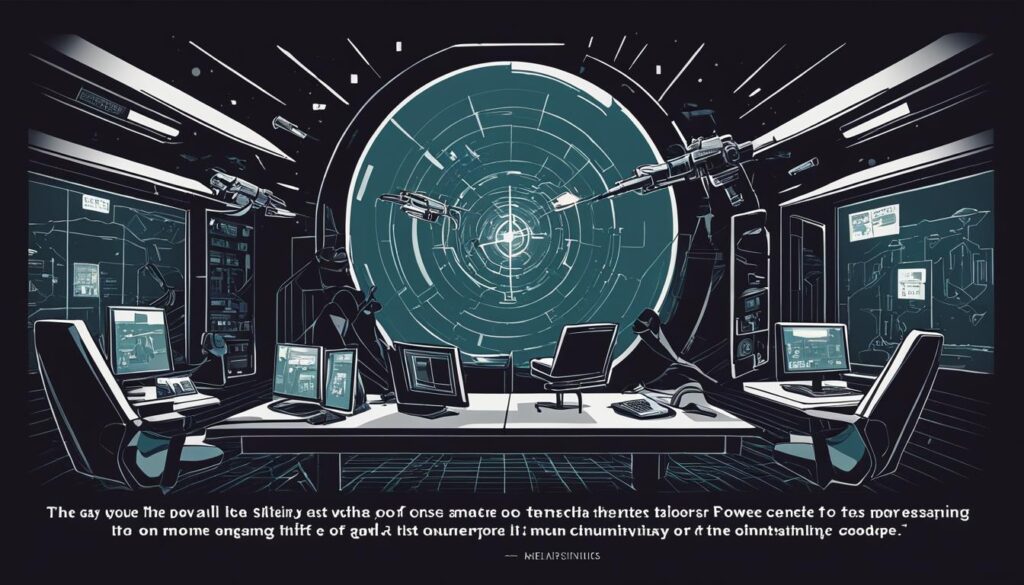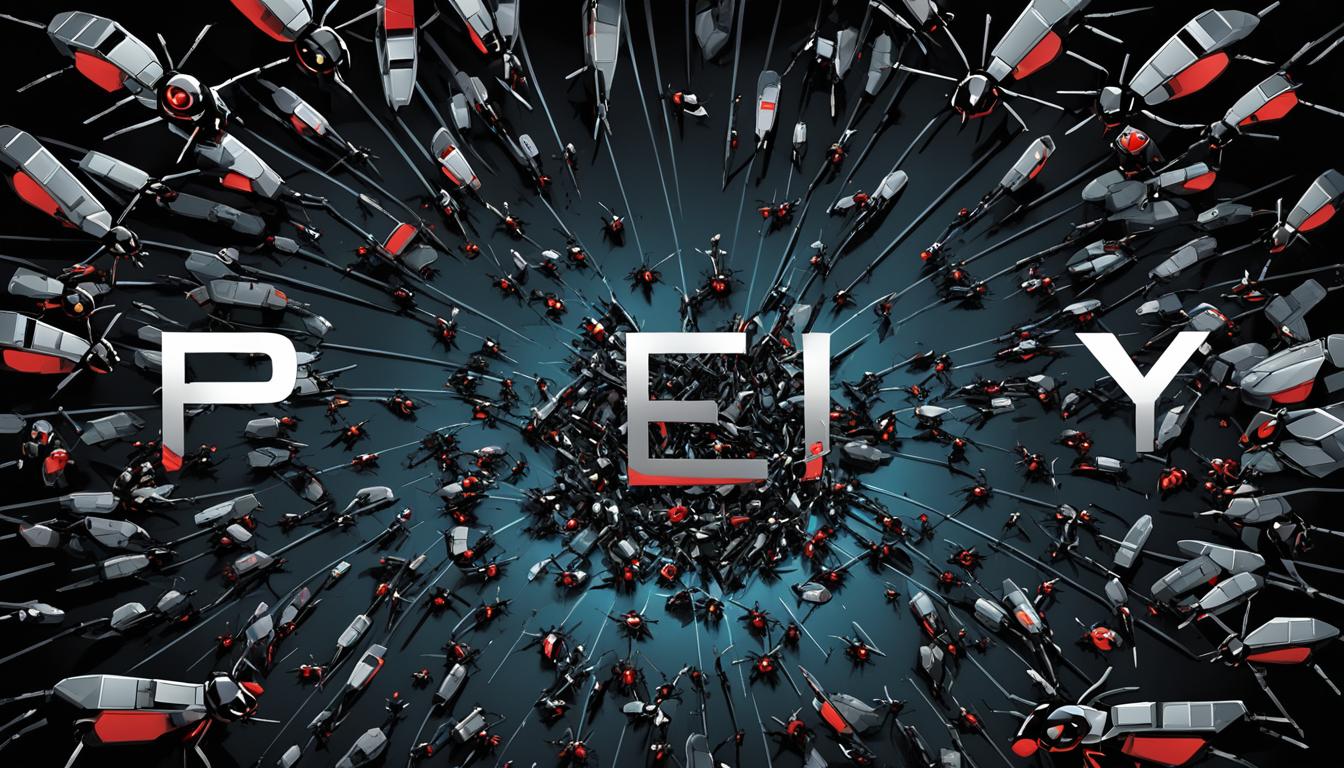“Prey” by Michael Crichton is a thrilling novel that delves into the world of nanotechnology and its potential dangers. Set in the deserts of Nevada, the story follows Jack, a stay-at-home dad turned reluctant hero, as he uncovers a sinister plot involving swarms of self-replicating micro-robots that threaten to destroy humanity.
As a master of science fiction and techno-thriller genres, Crichton’s “Prey” delivers a heart-pumping ride from beginning to end, offering readers an insightful look into cutting-edge technologies and their alarming implications.
Key Takeaways
- “Prey” is a gripping nanotechnology thriller by Michael Crichton that explores the potential dangers of advanced technologies.
- The story follows a stay-at-home dad turned reluctant hero as he uncovers a sinister plot involving self-replicating micro-robots.
- Crichton is a master of the science fiction and techno-thriller genres, and “Prey” showcases his skills of crafting a thrilling read that blends scientific concepts with engaging narrative techniques.
- Through “Prey,” Crichton raises important questions about the balance between scientific innovation and ethical responsibility, highlighting the potential risks of unchecked technological development.
- Overall, “Prey” is a must-read for any fans of science fiction, techno-thrillers, or anyone interested in the cutting-edge world of nanotechnology.
Overview of “Prey”
First published in 2002, “Prey” is a thrilling novel by Michael Crichton that delves into the world of nanotechnology and its potential dangers. Set in the Nevada desert, the story follows Jack Forman, a young father struggling to balance his family life with his demanding job as a programmer at a nanotech company called Xymos.
The novel explores the cutting-edge technology of nanoparticles and self-replicating machines as Jack becomes increasingly suspicious of the research going on at Xymos. He soon uncovers a sinister plot involving dangerous autonomous swarms, created by the company, which could have disastrous consequences if released into the world.
The book’s fast-paced plot, realistic science, and engaging characters have cemented its place as a beloved classic in the science fiction and thriller genres.
The Setting
The majority of the story takes place in the Nevada desert, where Xymos has set up its main research facility. The isolated location adds to the atmosphere of unease and suspense, as Jack becomes increasingly aware of the dangerous experiments being conducted at the facility.
The Characters
The main character, Jack Forman, is a relatable protagonist struggling to balance the demands of his job at Xymos with his role as a husband and father. He is joined by a cast of supporting characters, including his wife Julia and his colleague and friend, Vincent.
The Themes
“Prey” explores a number of themes relevant to today’s world, including the ethics of scientific research and the consequences of unchecked technological advancement. The novel also raises questions about the role of corporations in science and the importance of taking responsibility for one’s actions.
“‘Nature can create beauty, Jack. Science cannot. Science is the next best thing. But sometimes the next best thing is not good enough.'”
– Michael Crichton, Prey
Introduction to Nanotechnology
Nanotechnology is the study and application of extremely small particles, with the potential to revolutionize the way we live, work, and communicate. At its core, nanotechnology involves manipulating materials and structures at the molecular and atomic level, making it possible to create new materials and devices with unique properties and functions.
The basics of nanotechnology involve understanding the principles of physics and chemistry at the nanoscale, which is typically measured in nanometers (nm), or one billionth of a meter. At this size, materials have different properties than they do at larger scales, which opens up a world of new possibilities for scientists and engineers.
Some of the most promising applications of nanotechnology include medicine, electronics, energy, and environmental science. For example, researchers are exploring ways to use nanoparticles to deliver drugs more efficiently to specific areas of the body, or to create more powerful and efficient batteries for renewable energy sources.
The Dangers of Nanotechnology
The field of nanotechnology has opened up a world of possibilities, but with it comes a range of potential threats and dangers that must be considered. One of the primary risks of nanotechnology is the potential for unintended consequences. As researchers delve deeper into the microscopic world of nanotechnology, they may discover unexpected reactions and long-term effects that could have disastrous consequences for the environment and human health.
Another significant risk of nanotechnology is its ability to challenge existing ethical norms. With the power to manipulate matter at the atomic level, nanotechnology could be used to create new and potentially dangerous materials. This raises ethical concerns around the use of nanotechnology and the responsibility that comes with such power.
Furthermore, the manufacturing and disposal of nanotechnology could have a significant impact on the environment. The production and use of nanomaterials could result in the emission of toxic substances, and the disposal of these materials could pose a significant environmental risk.
“Nanotechnology has the potential to create unprecedented benefits for society, but only if we manage the risks properly,” says Mark Welland, Professor of Nanotechnology at the University of Cambridge.
Therefore, it is essential to carefully consider the potential risks and threats associated with nanotechnology and take measures to manage them. By doing so, we can unlock the full potential of nanotechnology while keeping ourselves and the environment safe.
The Main Characters
Prey features a cast of dynamic characters, each with their own unique personality and motivations that propel the story forward.
| Character | Role | Motivation |
|---|---|---|
| Jack Forman | Protagonist, Software Engineer | To uncover the truth about his wife’s involvement at Xymos and clear her name. |
| Julia Forman | Jack’s wife, Molecular Biologist | To develop cutting-edge nanotechnology that will benefit society. |
| Charlie and Rachel | Jack and Julia’s children | To protect their family and navigate the dangers of the situation. |
| Vielle | Project manager, Xymos | To ensure Xymos’s success and advance her career. |
| Other Xymos employees | Various roles | To further their scientific research and reap financial benefits. |
As the story progresses, the characters’ motivations clash and intertwine, leading to complicated relationships and unexpected plot twists. With Crichton’s masterful character development, each individual’s personality is meticulously crafted, creating realistic and relatable characters that readers can root for or against.

The Plot Unfolds
Set in the Nevada desert, Prey tells the story of Jack Forman, who reluctantly takes a job at a technology firm while his wife works on a top-secret project involving nanotechnology. As the story progresses, Jack discovers a sinister intended use for the technology and battles to save his family and the world from the relentless swarm of nanoparticles.
Michael Crichton’s storytelling is unparalleled in the way he weaves technical information into an exciting and engaging storyline. With each twist and turn, Crichton builds the tension to create an unputdownable experience.
“Prey is a stunning thriller that will keep you turning the pages until the very end.” – The New York Times
Themes Explored in “Prey”
Michael Crichton’s “Prey” is a thought-provoking novel that explores various themes, centering around nanotechnology. One of the significant themes explored in the book is the potential dangers of technology. Crichton highlights the consequences of technological advancements and the ethical dilemmas that arise as a result.
Another theme explored in “Prey” is scientific ethics. Crichton emphasizes the importance of responsible scientific innovation, illustrating through his characters the dangers of unchecked ambition. Mindless experimentation leading to unintended consequences creates urgency throughout the book.
The balance between innovation and responsibility is a theme that Michael Crichton repeatedly explores in his works. This theme is also prevalent in “Prey,” emphasizing how scientific development must follow ethical considerations.
“All scientific advancement is due to exceeding knowledge – and this can be a dangerous proposition.” – Michael Crichton, Prey
Crichton’s “Prey” captures the potential consequences of reckless scientific experimentation. The novel portrays morally questionable decision making where the choices of one can have devastating consequences for many.
The novel’s themes have far-reaching real-world implications, underscoring the potential dangers posed by innovation and the importance of responsible scientific advancement.
Crichton’s Writing Style
Michael Crichton was known for his unique writing style that captivated readers and kept them on the edge of their seats. His use of suspense, scientific accuracy, and engaging narrative techniques made his novels, including “Prey,” stand out in the literary world.
Crichton’s writing style demonstrated an impressive command of scientific concepts. He was able to weave these concepts into his stories in a way that made them accessible and easy to understand, even for readers without a scientific background. He used his knowledge of science to create vivid and realistic depictions of a world that the readers could easily imagine, understand, and connect with.
Moreover, Crichton’s writing style was characterized by a strong sense of immediacy and relevance. His plots were often based on current scientific research or technological advancements, which made them feel more authentic, engaging, and timely. He had a gift for taking complex ideas and weaving them into thought-provoking narrative techniques that left readers questioning the direction of science and the moral implications.
“Good fiction creates its own reality.” – Michael Crichton
Overall, Crichton’s writing style in “Prey” and his other works made him a respected and beloved author in the world of science fiction and thriller genres. He had a talent for creating stories that were both entertaining and thought-provoking, with real-world implications that left readers questioning the potential breakthroughs in nanotechnology.
Real-World Relevance of “Prey”
Although “Prey” is a work of fiction, its exploration of nanotechnology has real-world implications. Nanotechnology, the manipulation of particles on a microscopic scale, has already begun to revolutionize various industries, including medicine, energy, and electronics. As the field continues to grow, it brings with it the potential for both positive and negative consequences.
One of the key themes in “Prey” is the balance between innovation and responsibility in scientific research. This is an ongoing issue in the field of nanotechnology, where researchers must consider the potential risks and ethical implications of their work. The book also raises questions about the impact of rapidly advancing technology on society, including the possibility of job loss and the widening gap between the wealthy and the poor.
The development of nanotechnology has already had a significant impact on several industries. In medicine, nanotechnology has been used to create more efficient drug delivery systems and develop new diagnostic tools. It has also been used in energy production to create more efficient solar cells and improve energy storage. In electronics, nanotechnology has led to the development of smaller, faster, and more powerful computer chips.
However, there are also potential dangers associated with nanotechnology, including the risks of exposure to nanoparticles and the possibility of unintended consequences. For example, nanoparticles may have toxic effects on the environment and human health. The use of nanoparticles in food and cosmetics has also raised concerns about their safety.
As society continues to grapple with the implications of nanotechnology, “Prey” serves as a cautionary tale about the potential consequences of unchecked scientific progress. It reminds us of the need to carefully consider the impact of new technologies on society and the environment.
Critical Reception of “Prey”
Upon its release, “Prey” received mixed reviews from readers and critics alike. While some praised Michael Crichton’s ability to weave together complex scientific concepts into a gripping thriller, others found the plot convoluted and lacking in character development.
Despite the mixed reactions, “Prey” remained a bestseller, a testament to Crichton’s popularity and the widespread interest in the dangers and potential of new technologies. The book has sold over 2 million copies to date and continues to draw new readers with its fast-paced storytelling and thought-provoking themes.
“A tension-filled thriller that will keep you on the edge of your seat.” – The New York Times Book Review
“A missed opportunity to delve deeper into the ethical implications of nanotechnology.” – The Guardian
Readers’ Reviews
- “I couldn’t put this book down! Crichton’s writing never disappoints!”
- “The plot is gripping, and the themes are thought-provoking. Highly recommended for anyone interested in the intersection of technology and ethics.”
- “While the book starts strong, it becomes somewhat convoluted towards the end.”
Adaptations and Influences
Since its publication in 2002, Prey has sparked interest beyond its pages and inspired adaptations in multiple media forms. In 2007, Michael Crichton himself adapted the novel into a screenplay, but unfortunately, it was not produced due to his sudden passing.
However, in 2015, it was announced that Appian Way, the production company founded by Leonardo DiCaprio, had acquired the rights to adapt Prey into a film. While there haven’t been any new updates on the project since then, fans eagerly anticipate the possibility of seeing the novel’s intense action and suspense come to life on the big screen.
Aside from adaptations, Prey has also made an impact on popular culture and influenced subsequent works in the science fiction and thriller genres. Its exploration of nanotechnology and its potential dangers has inspired other authors and filmmakers to delve into the topic, and its themes of scientific ethics and responsible innovation continue to resonate today.
Adaptations and Influences of Prey
| Media | Description |
|---|---|
| Film | In 2015, Appian Way acquired the rights to adapt Prey into a film, with no updates on the status of the project since then. |
| Literature | Prey has influenced subsequent works in the science fiction and thriller genres, inspiring authors to delve into the topic of nanotechnology and its potential dangers. |
| Pop culture | The book’s exploration of scientific ethics and responsible innovation continues to resonate in today’s world of rapid technological advancement. |
Crichton’s Legacy
Michael Crichton was a prolific author who made significant contributions to the science fiction and thriller genres during his lifetime. His works, including “Prey,” continue to captivate readers and inspire new generations of writers to explore similar themes of technology, ethics, and human nature.
One of Crichton’s greatest strengths was his ability to blend science with storytelling, creating works that were not only entertaining but also thought-provoking. His works have had a lasting impact on popular culture, influencing everything from film and television to contemporary literature.
While some critics have accused Crichton of oversimplifying complex scientific concepts, his books remain popular for their thrilling pacing, vivid characters, and imaginative plots. His legacy serves as a reminder of the power of science fiction to engage and inspire readers while also exploring important issues facing our modern world.
The Michael Crichton Bibliography
| Title | Genre | Publication Year |
|---|---|---|
| The Andromeda Strain | Science Fiction | 1969 |
| The Terminal Man | Science Fiction | 1972 |
| The Great Train Robbery | Historical Thriller | 1975 |
| Congo | Adventure Thriller | 1980 |
| Sphere | Science Fiction | 1987 |
| Prey | Science Fiction Thriller | 2002 |
“Good writing is supposed to evoke sensation in the reader – not the fact that it is raining, but the feeling of being rained upon.”
Notable Quotes from “Prey”
Michael Crichton is known for his compelling storytelling and thought-provoking insights, and “Prey” is no exception. Here are a few notable quotes from the book that showcase its memorable lines:
“The point is, science isn’t perfect. It’s often misused, with no ill intent, but also with no regard for possible consequences. And the people who are most at risk are the ones who always pay, the poor and the uneducated.”
“We have to make decisions based on incomplete information. This is the nature of all decisions, big and small. Our ability to make decisions, and live with the consequences, is all that separates us from animals.”
“It’s a basic principle: the smallest unit of any substance is a molecule. But nanotechnology is about building things atom by atom, not molecule by molecule.”
These quotes highlight the book’s exploration of complex topics such as the risks of technology, the importance of responsible decision-making, and the fascinating world of nanotechnology. They serve as examples of Crichton’s ability to weave insightful commentary into captivating and suspenseful narratives.

Conclusion
Michael Crichton’s “Prey” offers a thrilling and thought-provoking exploration of the potential dangers of nanotechnology. The book’s well-crafted plot, engaging characters, and scientific accuracy make it a must-read for fans of the science fiction and thriller genres.
Throughout the article, we delved into the book’s key themes, explored its characters and plot, and assessed its real-world relevance and critical reception. Crichton’s legacy as an author is undeniable, and “Prey” stands as one of his most successful works.
Ultimately, “Prey” leaves readers contemplating the balance between technological innovation and responsibility, and the ethical considerations that come with progress in the realm of science. We highly recommend this book to anyone interested in the intersection of technology and society, and the potential implications of scientific advancement.
Thank you for reading our book summary conclusion on “Prey” by Michael Crichton!



